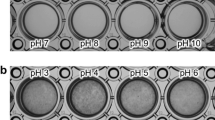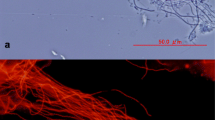Abstract
Occurrence of epibiont attachment on filamentous bacteria is a common phenomenon in activated sludge. In this study, an attempt has been made to elucidate the intrinsic nature of the attachment between the epibionts and filamentous bacteria based on microscopic observations. Characterization of the epiflora based on fluorescence in situ hybridization using group level probes revealed that the epibionts colonizing these filamentous bacteria largely belongs to the class Alphaproteobacteria, followed by Beta and Gammaproteobacteria. The ultrastructural examination using transmission electron microscopy pointed to the existence of a possible cell-to-cell interaction between epibionts and the selected filaments. Common bacterial appendages such as pili and fimbria were absent at the interface and further noted was the presence of cell membrane extensions on epibiont bacteria protruding towards the targeted filamentous cell. Fibrillar structures resembling amyloid-like proteins were observed within the filament cells targeted by the epibionts. An interaction was apparent between amyloid such as proteins and epibionts with regards to the direction of fibrillar structures and the distance of approaching epibiont bacteria. Due to the lack of visual evidence in support of penetration, the role of these amyloid-like fibrils as potential attachment sites for the epibionts was taken into consideration, and required further validation using conformational antibodies.







Similar content being viewed by others
References
Amann R (1995) In situ identification of micro-organisms by whole cell hybridization with rRNA-targeted nucleic acid probes. In: Akkermans AL, Van Elsas J, De Bruijn F (eds) Molecular microbial ecology manual. Springer, Netherlands, pp 331–345
Chong G, Kimyon O, Rice SA, Kjelleberg S, Manefield M (2012) The presence and role of bacterial quorum sensing in activated sludge. Microb Biotechnol 5:621–633
Cullen PJ, Sprague GF (2002) The roles of bud-site-selection proteins during haploid invasive growth in yeast. Mol Biol Cell 13:2990–3004
Daims H, Bruhl A, Amann R, Schleifer K, Wagner M (1999) The domain-specific probe EUB338 is insufficient for the detection of all bacteria: development and evaluation of a more comprehensive probe set. Syst Appl Microbiol 22:434–444
Diao HF, Li XY, Gu JD, Shi HC, Xie ZM (2004) Electron microscopic investigation of the bactericidal action of electrochemical disinfection in comparison with chlorination, ozonation and fenton reaction. Process Biochem 39:1421–1426
Dueholm MS, Petersen SV, Sønderkær M, Larsen P, Christiansen G, Hein KL, Enghild JJ, Nielsen JL, Nielsen KL, Nielsen PH, Otzen DE (2010) Functional amyloid in Pseudomonas. Mol Microbiol 77:1009–1020
Eikelboom DH (2000) Process control of activated sludge plants by microscopic investigation. IWA Publishing, London
Fowler DM, Koulov AV, Balch WE, Kelly JW (2007) Functional amyloid—from bacteria to humans. Trends Biochem Sci 32:217–224
Freire S, de Araujo MH, Al-Soufi W, Novo M (2014) Photophysical study of Thioflavin T as fluorescence marker of amyloid fibrils. Dyes Pigm 110:97–105
González-Brambila M, Monroy O, López-Isunza F (2006) Experimental and theoretical study of membrane-aerated biofilm reactor behavior under different modes of oxygen supply for the treatment of synthetic wastewater. Chem Eng Sci 61:5268–5281
Hartmann M, Berditsch M, Hawecker J, Ardakani MF, Gerthsen D, Ulrich AS (2010) Damage of the bacterial cell envelope by antimicrobial peptides Gramicidin S and PGLa as revealed by transmission and scanning electron microscopy. Antimicrob Agents Chemother 54:3132–3142
Jenkins D, Richard MG, Daigger GT (2004). Manual on the causes and control of activated sludge bulking. foaming and other solids seperation problems. IWA publishing, UK
Jordal PB, Dueholm MS, Larsen P, Petersen SV, Enghild JJ, Christiansen G, Højrup P, Nielsen PH, Otzen DE (2009) Widespread abundance of functional bacterial amyloid in mycolata and other Gram-positive bacteria. Appl Environ Microbiol 75:4101–4110
Kragelund C, Caterina L, Borger A, Thelen K, Eikelboom D, Tandoi V, Kong Y, van der Waarde J, Krooneman J, Rossetti S, Thomsen TR, Nielsen PH (2007) Identity, abundance and ecophysiology of filamentous Chloroflexi species present in activated sludge treatment plants. FEMS Microbiol Ecol 59:671–682
Larsen P, Nielsen JL, Dueholm MS, Wetzel R, Otzen D, Nielsen PH (2007) Amyloid adhesins are abundant in natural biofilms. Environ Microbiol 9:3077–3090
Liu Z, Wang Y, He N, Huang J, Zhu K, Shao W, Wang H, Yuan W, Li Q (2011) Optimization of polyhydroxybutyrate (PHB) production by excess activated sludge and microbial community analysis. J Hazard Mater 185:8–16
Manz W, Amann R, Ludwig W, Wagner M, Schleifer K (1992) Phylogenetic oligodeoxynucleotide probes for the major subclasses of proteobacteria—problems and solutions. Syst Appl Microbiol 15:593–600
Manz W, Amann R, Ludwig W, Vancanneyt M, Schleifer K (1996) Application of a suite of 16S rRNA-specific oligonucleotide probes designed to investigate bacteria of the phylum cytophaga-flavobacter-bacteroides in the natural environment. Microbiology 142:1097–1106
McIlroy S, Nielsen P (2014) The family Saprospiraceae. In: Rosenberg E, DeLong E, Lory S, Stackebrandt E, Thompson F (eds) The prokaryotes. Springer, Berlin Heidelberg, pp 863–889
Nielsen PH, Kragelund C, Seviour RJ, Nielsen JL (2009) Identity and ecophysiology of filamentous bacteria in activated sludge. FEMS Microbiol Rev 33:969–998
Otzen D (2010) Functional amyloid: turning swords into plowshares. Prion 4:256–264
Rambaran RN, Serpell LC (2008) Amyloid fibrils. Prion 2:112–117
Romero D, Aguilar C, Losick R, Kolter R (2010) Amyloid fibers provide structural integrity to Bacillus subtilis biofilms. Proc Natl Acad Sci USA 107:2230–2234
Sujatha K, Mahalakshmi A, Shenbagarathai R (2005) A study on accumulation of PHB in native Pseudomonas isolates LDC-5 and LDC-25. Indian J Biotechnol 4:216–221
Suzuki T, Ishihara H, Toyoda K, Shiraishi T, Kunoh H, Takada J (2013) Autolysis of bacterial cells leads to formation of empty sheaths by Leptothrix spp. Minerals 3:247–257
Wang B-B, Chang Q, Peng D-C, Hou Y-P, Li H-J, Pei L-Y (2014) A new classification paradigm of extracellular polymeric substances (EPS) in activated sludge: separation and characterization of exopolymers between floc level and microcolony level. Water Res 64:53–60
Williams TM, Unz RF (1985) Filamentous sulfur bacteria of activated sludge: characterization of Thiothrix, Beggiatoa, and Eikelboom type 021N strains. Appl Environ Microbiol 49:887–898
Xia Y, Kong Y, Thomsen TR, Halkjær Nielsen P (2008) Identification and ecophysiological characterization of epiphytic protein-hydrolyzing Saprospiraceae (“Candidatus epiflobacter” spp.) in activated sludge. Appl Environ Microbiol 74(7):2229–2238
Young KD (2006) The selective value of bacterial shape. Microbiol Mol Biol Rev 70(3):660–703
Zhou Y, Blanco L, Smith D, Chapman M (2012) Bacterial amyloids. In: Sigurdsson EM, Calero M, Gasset M (eds) Amyloid proteins: methods in molecular biology vol 849. Humana Press, New York, pp 303–320
Acknowledgements
We are thankful to Phillip Christopher and Vishal Bharuth, Microscopy and Microanalysis Unit, University of Kwa Zulu Natal for the supervision of the TEM and SEM work conducted. Equally grateful to Valter Tandoi, CNR, Italy for the editorial assistance. Caterina Levantesi, CNR, Italy for the assistance with the FISH analysis. Our gratitude also goes out to Per H. Nielsen, Department of Biotechnology, Aalborg University, Denmark for availing facilities to conducting certain aspects of work done in this study. Morten S. Dueholm, Department of Biotechnology, Aalborg University, Denmark, for overseeing the ThT staining of amyloid protein. This work is based on the research supported by the South African Research Chairs Initiative of the Department of Science and Technology and National Research Foundation of South Africa.
Author information
Authors and Affiliations
Corresponding author
Ethics declarations
Conflict of interest
The authors declare they have no conflict of interest.
Additional information
Communicated by Erko Stackebrandt.
Rights and permissions
About this article
Cite this article
Conco, T., Kumari, S., Stenström, T. et al. Epibiont growth on filamentous bacteria found in activated sludge: a morphological approach. Arch Microbiol 200, 493–503 (2018). https://doi.org/10.1007/s00203-017-1461-3
Received:
Revised:
Accepted:
Published:
Issue Date:
DOI: https://doi.org/10.1007/s00203-017-1461-3




